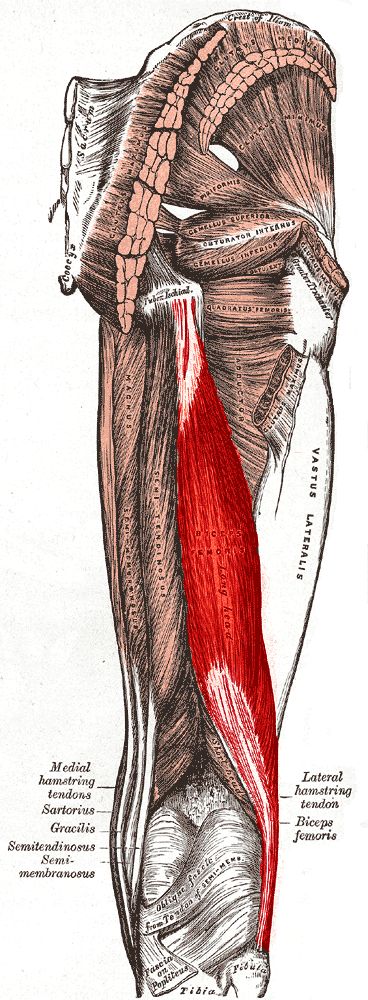yogabook / muscles / biceps femoris

Linkmap

M. biceps femoris (Bein)
Part of the hamstrings and one of the main knee joint flexors, consisting of 2 heads:
- caput longum: originates at the lower posterior lateral ischial tuberosity
- caput breve: originates on the back of the middle femur
Both heads flex in the knee joint and exorotate the lower leg in the knee joint when the knee joint is flexed. The monoarticular caput breve has no other function; the biarticular caput longum is also involved in extension in the hip joint. In postures with strong hip extension and a flexed knee joint, it sometimes tends to spasm due to the very short length of the sarcomere. Postures with a widely flexed hip joint and flexed knee joint, such as hip opening III, are often limited by it; it can then be felt with its strongly taut tendon in the outer rear side of the knee joint.
The differentiating attachment tendon has a connection to the tendon of the popliteus and the arcuate popliteal ligament as well as a separation to the tibia.
Origin:
- caput longum: ischial tuberosity (ischial tuberosity)
- caput breve: back of femur (labium laterale linea asperae), septum intermusculare femoris laterale
Attachment: caput fibulae of the fibula (head of the fibula): the attachment tendon surrounds the distal attachment of the lateral collateral ligament:
- a superficial part lies laterally on
- a middle part wraps around the distal attachment
- one part more profound than the lateral collateral ligament
Innervation: Caput longum: Nervus tibialis from plexus sacralis (L5-S2); Caput breve Nervus fibularis communis (L5-S2)
Antagonists: M. quadriceps
Movement: Extension and exorotation of the lower leg (long head only), flexion of the knee joint
Strengthening postures (722): Deadlift, 3rd warrior pose, 3rd warrior pose: backwards against the wall, uttanasana: right-angled
Stretching postures (721): ardha baddha padma pascimottanasana, tryangamukhaikapada pscimottanasana, pascimottanasana, janu sirsasana, parivrtta janu sirsasana, parsva upavista konasana, upavista konasana: forward bend, parivrtta parsva upavista konasana, uttanasana, prasarita padottanasana, 3. Warrior pose, trikonasana, parivrtta trikonasana, ardha chandrasana, parivrtta ardha chandrasana, 5. Hip opening, handstand: eka pada, hanumanasana, hasta padangusthasana, downface dog, headstand: eka pada, krouncasana, supta krouncasana, parsvottanasana, right-angled handstand, right-angled elbowstand, back extension, shoulderstand: eka pada, supta konasana, supta padangusthasana, vasisthasana, deadlift
Tests
definite yoga Flexibilitätstest Bizeps femoris in Hüftöffnung 3,
definite yoga Flexibilitätstest Ischiocrurale Gruppe in parivrtta trikonasana
